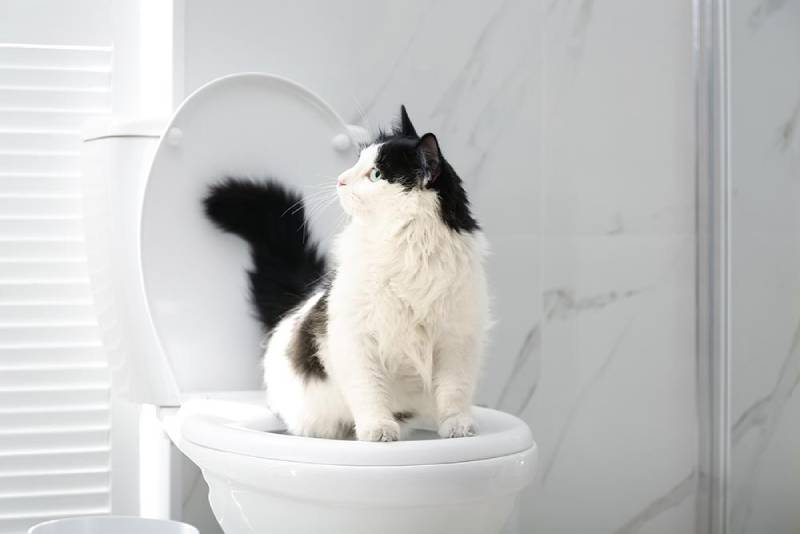Potential Issues of Flushing Cat Poop Down Your Toilet - Protect Your Plumbing
Potential Issues of Flushing Cat Poop Down Your Toilet - Protect Your Plumbing
Blog Article
We have come across this great article about Can You Flush Cat Poo or Litter Down the Toilet? directly below on the internet and thought it made good sense to relate it with you in this article.

Intro
As feline owners, it's essential to bear in mind just how we deal with our feline close friends' waste. While it may seem practical to flush pet cat poop down the toilet, this practice can have damaging effects for both the setting and human health.
Alternatives to Flushing
Luckily, there are more secure and much more liable methods to dispose of pet cat poop. Take into consideration the following options:
1. Scoop and Dispose in Trash
The most common approach of disposing of pet cat poop is to scoop it right into a naturally degradable bag and throw it in the trash. Make sure to make use of a committed clutter scoop and throw away the waste promptly.
2. Usage Biodegradable Litter
Opt for eco-friendly feline clutter made from products such as corn or wheat. These clutters are environmentally friendly and can be safely gotten rid of in the trash.
3. Bury in the Yard
If you have a lawn, consider burying pet cat waste in a marked area away from veggie gardens and water resources. Be sure to dig deep enough to avoid contamination of groundwater.
4. Install a Pet Waste Disposal System
Invest in a pet dog garbage disposal system particularly created for pet cat waste. These systems use enzymes to break down the waste, lowering odor and ecological effect.
Health Risks
Along with ecological issues, flushing feline waste can additionally present health threats to human beings. Cat feces may contain Toxoplasma gondii, a bloodsucker that can cause toxoplasmosis-- a potentially severe ailment, especially for pregnant ladies and individuals with weakened immune systems.
Environmental Impact
Flushing cat poop introduces damaging pathogens and parasites into the water system, presenting a considerable risk to water environments. These contaminants can negatively impact aquatic life and compromise water high quality.
Verdict
Accountable family pet ownership extends past providing food and shelter-- it additionally includes proper waste administration. By avoiding purging cat poop down the bathroom and opting for different disposal methods, we can minimize our environmental impact and protect human health and wellness.
Why Can’t I Flush Cat Poop?
It Spreads a Parasite
Cats are frequently infected with a parasite called toxoplasma gondii. The parasite causes an infection called toxoplasmosis. It is usually harmless to cats. The parasite only uses cat poop as a host for its eggs. Otherwise, the cat’s immune system usually keeps the infection at low enough levels to maintain its own health. But it does not stop the develop of eggs. These eggs are tiny and surprisingly tough. They may survive for a year before they begin to grow. But that’s the problem.
Our wastewater system is not designed to deal with toxoplasmosis eggs. Instead, most eggs will flush from your toilet into sewers and wastewater management plants. After the sewage is treated for many other harmful things in it, it is typically released into local rivers, lakes, or oceans. Here, the toxoplasmosis eggs can find new hosts, including starfish, crabs, otters, and many other wildlife. For many, this is a significant risk to their health. Toxoplasmosis can also end up infecting water sources that are important for agriculture, which means our deer, pigs, and sheep can get infected too.
Is There Risk to Humans?
There can be a risk to human life from flushing cat poop down the toilet. If you do so, the parasites from your cat’s poop can end up in shellfish, game animals, or livestock. If this meat is then served raw or undercooked, the people who eat it can get sick.
In fact, according to the CDC, 40 million people in the United States are infected with toxoplasma gondii. They get it from exposure to infected seafood, or from some kind of cat poop contamination, like drinking from a stream that is contaminated or touching anything that has come into contact with cat poop. That includes just cleaning a cat litter box.
Most people who get infected with these parasites will not develop any symptoms. However, for pregnant women or for those with compromised immune systems, the parasite can cause severe health problems.
How to Handle Cat Poop
The best way to handle cat poop is actually to clean the box more often. The eggs that the parasite sheds will not become active until one to five days after the cat poops. That means that if you clean daily, you’re much less likely to come into direct contact with infectious eggs.
That said, always dispose of cat poop in the garbage and not down the toilet. Wash your hands before and after you clean the litter box, and bring the bag of poop right outside to your garbage bins.
https://trenchlesssolutionsusa.com/why-cant-i-flush-cat-poop/

Hopefully you enjoyed our part about How to Dispose of Cat Poop and Litter Without Plastic Bags. Many thanks for finding the time to browse our short article. Do you know another individual who is in the market for the topic? Feel free to share it. I am grateful for your time. Don't hesitate to stop by our blog back soon.
Get Estimate Report this page